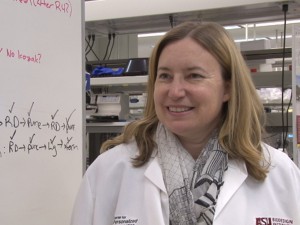- Slug:BIZ-biomarkers, About 550 words
- Photos available (thumbnails, cutlines below)
By MERYL FISHLER
Cronkite News
TEMPE – Arizona State University researchers said they have identified three promising biological signals that could help detect ovarian cancer before patients display any symptoms.
Researchers from the Biodesign Institute said identifying the biomarkers – a type of blood-born signal – is another step toward early detection.
ASU’s new study is the first use of high density microarray technology that uses a sample of the patient’s blood to identify biomarkers for ovarian cancer, researchers said.
Ovarian cancer is the fifth leading cause of cancer-related deaths for women, according to the Ovarian Cancer National Alliance.
Doctors generally don’t diagnose the cancer until it’s in the advanced stages, and only 15 percent of ovarian cancer patients are diagnosed early, according to the alliance.
In the U.S., ovarian cancer is the most lethal gynecological cancer “with over 15,000 deaths per year,” said Dr. Kristina Butler, a gynecological oncology specialist at the Mayo Clinic in Scottsdale.
“Ovarian cancer is often detected late in its course, and by the time it is detected, it is too late to really have a big impact,” said Dr. Josh LaBaer, director of ASU’s Biodesign Center for Personalized Diagnostics.
Researchers said the biomarkers can combat that late detection.
Biomarkers are autoantibodies, a type of protein produced by the immune system. These autoantibodies don’t cause the disease. Rather, they act as an early warning system that abnormal proteins produced by cancer are present in the body.
Physicians already use biomarkers to diagnose other diseases. For example, cholesterol tests are biomarkers for heart disease, and blood pressure can indicate hypertension.
The institute, which focuses its research on finding natural solutions to address global challenges in health care, also is researching biomarkers in other cancers, including breast cancer.
Karen Anderson, a researcher at the institute, and LaBaer started out with about 10,000 possible biomarkers for ovarian cancer and after about 10 years of research, they narrowed it down to about a dozen biomarkers.
The institute used the microarray technology to identify three of these autoantibodies as promising biomarker candidates in the new study.
“Now it is time to come up with more serious validation studies to figure out how to put them together in a panel to get a better test,” LaBear said.
Some of the biomarkers discovered by ASU are in the clinical studies phase, and researchers must validate and vet the findings in national studies, Anderson said.
The current tests used for screening for other types of cancer ¬– like mammograms or colonoscopy – are great tools, but they are expensive.
“If we use that as a benchmark for what these tests usually cost,” blood tests can be more cost effective, Anderson said.
Diagnostic tests similar to what the researchers are trying to develop are relatively inexpensive, Anderson said. The molecular test for colon cancer only runs in the several hundred-dollar range.
^__=

Karen Anderson, a researcher at the Biodesign Institute, started out with about 10,000 possible biomarkers for ovarian cancer. (Cronkite News photo by Brooke Wasowicz)
^__=
Researchers with the Biodesign institute, which focuses its research on finding natural solutions to address global challenges in health care, also looking at biomarkers in other cancers, including breast cancer. (Cronkite News photo by Meryl Fishler)
^__=
New research conducted by the Biodesign Institute at Arizona State University identifies three promising biomarkers candidates that may help detect ovarian cancer before patients feel the symptoms.
(Cronkite News photo by Meryl Fishler)

